Alternating Current (AC) is a certain form of electric current generally employed in businesses and homes. Contrary to Direct Current (DC), AC is provided as the result of the motion of electrical charges in a particular direction that modifies over a period within a medium like a wire. Direct current, on the other hand, slides only in one direction.
What are the Advantages of Alternating Current?
An alternating current is a type of current whose direction and magnitude modifies periodically; this expression also works on alternating voltage. The electrical principles generally also apply to the engineering aspect of alternating current; a few features have to be considered, however.
An alternating current is a type of current whose amplitude and direction change regularly; the same statement also applies to alternating voltage. The use of electrical items necessitates the use of Products with Alternating Current. Several Suppliers And Companies, as well as other manufacturers and distributors, supply Alternating Current and equipment, and there are many alternating current devices for sale on Linquip.
There is a complete list of alternating current services on the Linquip website that meets all of your needs. Linquip vendors can assist you with this. Please contact Linquip’s Alternating Current Experts for additional information on how to connect with a wide choice of service providers who consistently deliver the highest quality items.
Of the different possible types, the sinusoidal wave of alternating current has the highest importance. The main advantages of alternating current are as follows:
- Economical and simple production
- Low-waste energy-transmission in large distances
- Easy transformation into other types based on the principle of mutual induction
- The sinusoidal type is not varied by the main components, including L, R, and C
According to these and other benefits, the engineering aspect of alternating current is too important. If the direct current is needed (e.g. for the running of the majority of electronic instruments), it can simply be generated by using a rectifier on the alternating current. Especially in electrical energy engineering, alternating current is practically employed due to many advantages. This is a current whose direction and value changes based on the frequency. The sinusoidal wave of alternating current has the highest importance. If you want to see the advantages of alternating current more precisely, visit here.
Characteristics of Alternating Current
Alternating current and alternating voltage are created in particular generators. Explanations in complete detail are presented below.
When rotating a coil (provided by a conductor loop in the next diagram) in a magnetic circuit, a voltage that can run a current is produced in this coil. The direction can be specified by using the right-hand rule. At a fixed rotational velocity, the direction and magnitude of the produced voltage are based on the location of the conductor loop.
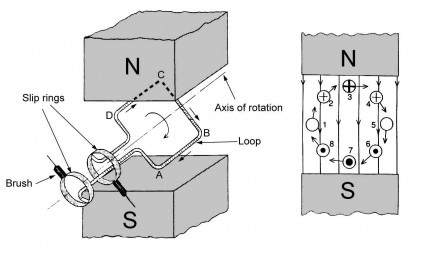
The total amount of magnetic flux penetrates the system in the horizontal position, DF/Dt has the lowest value, and the produced voltage is equal to zero. The rate of flux difference or DF/Dt is maximum in the vertical position, and the produced voltage has the greatest value (Vertical position means that system is parallel to the magnetic fields). With more rotation, the voltage again reduces and after half a cycle reaches the amount of zero.
In the next cycle, the voltage modifies its direction and is close to its maximum negative amount in vertical format. The initial state is again reached after one full cycle, the voltage has reduced to zero, and another period with precisely the same course can start. In the figure below, the explained states are presented for some selected points of the conductor. The function of the curve is like a sine wave.
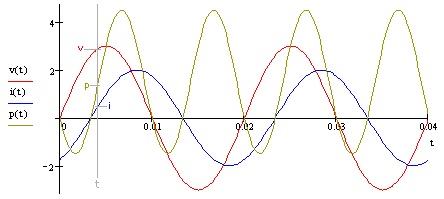
The angle is frequently introduced by a circular measurement; the correlation is simply obtained by the circumference of a circle, including the radius r = 1. So, we have the circumference of a circle as:
C = 2r\pi = 2\pi
The perigon of the shape is 360°.
The voltage and current value provided in the last figure is introduced as cycle, oscillation, or wave. Each wave is constructed of a negative and a positive half-section. The required time for a whole revolution of the conductor cycle is known as the duration of a cycle or time of oscillation. The angular speed at which the conductor cycle circulates is the main angle which the loop has determined in a particular unit of time. With a region of 360°, the time of a cycle or T is needed. The angular speed is generally introduced as angular frequency expressed with ω in engineering, and it is calculated as
\omega =\frac{2\pi }{T}
where ω is the angular frequency, and T is the duration of a cycle.
The angle of this section is introduced as phase angle or, briefly, phase. The phase is the term of oscillation obtained at a certain time, which is recovered at equal time intervals.
The number of waves or cycles generated in a certain time is called the frequency of the alternating current or alternating voltage (introduced by f). The higher the duration of a cycle, the lower the frequency. The next diagram shows two various diagrams for a particular duration. The frequency can be evaluated by:
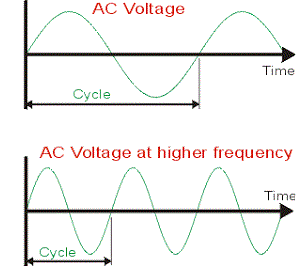
f=\frac{1}{T}
The unit of frequency is introduced as Hz=Hertz in honor of the German physicist Heinrich Hertz (1857 – 1894). The following subunits are frequently needed:
- 1 kHz = 1 kilohertz equal to 103 Hz
- 1 MHz = 1 megahertz equal to 106 Hz
- 1 GHz = 1 gigahertz equal to 109 Hz
The other rarely utilized feature of the electrical wave is the wavelength introduced by (λ). Wavelength is the length value of a wave detected with the unit of length (e.g., m, km, cm, mm). As the electrical energy can be measured by the light velocity or C = 300,000 km/s. The distance where a wave extends can be estimated based on the main frequency. So, we have:
C=\lambda f
After inversion, we can achieve the wavelength as
\lambda=\frac{C}{f}
The magnitude of the alternating current or the alternating voltage can be measured on the foundation of the sinusoidal wave explained before. The maximum amount occurring at 270° and 90° is called the maximum value, peak value, or amplitude and is determined by all other amounts which are very continuous. So, it can be different at any time, which is introduced as instantaneous values and are expressed by u (or i).
When the peak value is equal to the instantaneous values, it can be sensed at any time. The main equation of a sinusoidal alternating wave is
u=sin(\omega t)
where u is the instantaneous value, peak value, maximum value, or amplitude, and sin ωt is the factor of the sine wave at a particular angle.
Alternating current processes are generally provided in diagrams, which present a better survey in addition to the exclusively mathematical equations. Vector and line diagrams are particularly suitable for this aim.
What Are Some Advantages of AC Over DC?
AC is easier to manufacture than DC. It is also less costly to produce than DC. AC systems, such as AC generators, are more efficient than DC systems. During electric operation, the amount of power wasted through AC is small. It can use transformers to supply electricity to loads across long distances. AC generators are more durable and simpler to construct than DC generators. Brushes and commutators are required to create DC in DC generators.
Vector Diagram to Define the Advantages of Alternating Current
The alternating current or the alternating voltage is represented by a vector or pointer capable of circulating whose length according to the maximum value. This vector rotates anticlockwise at the particular angular velocity. The vector position at any time determines the location of the conductor loop. A straight line is drawn from the vector tip to the horizontal axis, which crosses from the midpoint of the circle in order to identify the instantaneous current or voltage for any suitable position.
The length of that line is based on the instantaneous value of the system. The main benefit of the vector presentation is lucidity; however, the disadvantage of this diagram is the particular conditions that can be represented just for a few selected instants or for one point of time.
Line Diagram to Show the Advantages of Alternating Current
The alternating current or alternating voltage is shown by a sinusoidal diagram from which the values for all variations can be sensed. The line shape can be improved by the vector diagram in the following method.
First, a horizontal line should be drawn close to the vector diagram. This line is divided into sections, the shortest one being similar to the duration of one period (T) or into certain degrees up to 360o. Then, vertical lines are used on these points of division, which resemble the shapes on the vector presentation as to size and direction. The sine wave can be achieved when connecting the endpoints of the vertical lines are completed. The next Figure presents this construction.
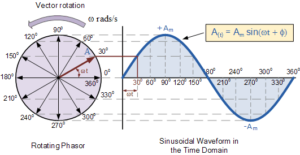
The main benefit of the line diagram is the possibility of providing all of the instantaneous values; however, a disadvantage of this method is the limited lucidity particularly when several diagrams should be represented.
List of Key Advantages of Alternating Current
Efficient Power Transmission
Although in the beginning, AC and DC electric formats employed to waste transmission when long lines are utilized, Tesla and Westinghouse made use of great voltage transmission paths to revise this problem and presented one of the important advantages of alternating current. Before, power is estimated to obtain steady transmission. This is owing to the fact that resistance should be used in the wires. Whenever a long line form of transmission is employed, power is wasted. Because of the high voltage applied to have a steady source of electric power and smaller current crosses through the power line, this also results in reducing the power loss.
Gives Power Generation
After the invention of the Alternating system, the AC generators were produced as well. This started the invention of AC generators in the type of hydroelectric forms that are still utilized up to this day. They are simpler in comparison to the mechanical production from DC and improve the advantages of alternating current.
Made Power Consumption Possible
With the absence of brushes and commutators that DC instruments utilize to create electricity, power consumption is one of the considerable advantages of Alternating Current. The first AC induction generator was designed by Tesla in the late 1800s and was employed alongside AC power. This innovation found its way to various industries in the United States. Now, this combination of engineering is still being utilized by households and is used for garbage disposers, power electric fans, and particular compressors for air-conditioners. It is also suitable to employ than its counterpart.
Supplies Better Lighting
Incandescent lights or bulbs that are constructed practically by Thomas Edison can operate employing both DC and AC, but the more actual fluorescent lights use a large amount of voltage. These lights utilize gases like argon and mercury vapor, and high voltage makes it possible to generate an ultraviolet spectrum. AC is the more beneficial form of electric power to use, particularly that more compact lights like fluorescents are becoming usual.
Lower in Cost and Available
Alternating current is also accessible in abundance and is introduced to be less expensive. Availability of AC form is better in comparison with DC type and is lesser in price than DC, which also provides lower current. These two properties make it more practical and suitable than its counterpart.
Download Advantages of Alternating Current PDF
Visit here to know the fundamentals and advantages of AC.
Buy Equipment or Ask for a Service
By using Linquip RFQ Service, you can expect to receive quotations from various suppliers across multiple industries and regions.
Click Here to Request a Quotation From Suppliers and Service Providers
Read More on Linquip
- What is AC Circuit and Its Characterization?
- What Is a Digital Potentiometer? An Explanation of the Working Principle and Advantages
- 5 Types of Proximity Sensors (Application and Advantages)
- What are the Advantages of AC over DC?
- Thermocouple vs. Thermopile: A Complete Comparison & Advantages of Each Type
- Top 10 Machine Shops in Tampa in 2022 (Clear Guide)
- 10 Types of Molding Machinery + PDF (Clear Guide)
- 3 Common Types of Electrical Connectors (Clear Guide)
- Types of Sensors Detectors/Transducers: An Entire Guide
- 15 Types of Electrical Power Connectors (Clear Guide) + PDF
- The 8 Best Circuit Breaker Locators in 2022
- The 10 Best Mini/Benchtop Milling Machine in 2022
- 10 Best CNC Machines & Routers for WoodWorking in 2022
- The 8 Best Rust Converters in 2022 (Review Guide)
- What is the Difference between Direct Current and Alternating Current?
- Types of Capacitors: All You Need to Know

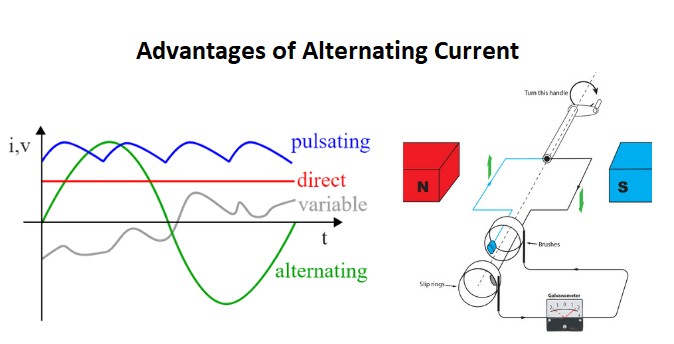


Autor writes “(DC) which also provides lower current”
??
-Did he sleep during physics classes?
Low, low, low quality
In some applications, particular adaptors can be employed to achieve lower current.
Thank you for your comment